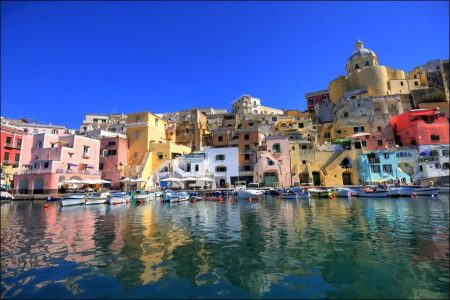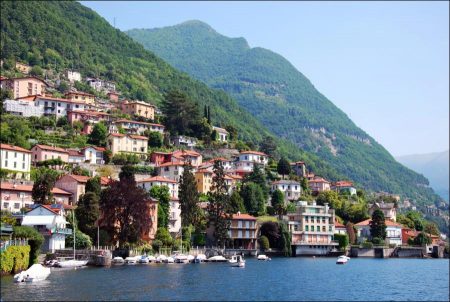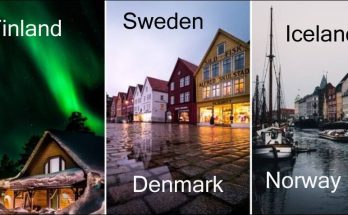Although rocks of no great age, geologically speaking, outcrop over much of the surface of Italy, almost every geological period is represented somewhere in the country. A great variety of different types of rock is also to be found, and it is the nature of these rocks and the way in which they have been formed and now outcrop rather than their age, that help to account for present land forms.
Lower Paleozoic rocks appear at the surface only in a few localities, being most extensive in the southern half of Sardinia, where they include limestones and are highly folded, but old rocks occur also in the Alps. The Carboniferous rocks of Italy differ markedly from those further north in Europe in having very few coal deposits, because conditions were less favourable for their formation. During Carboniferous and Permian times Italy, like areas further north, was affected by the Hercynian earth movements, and mountains were formed in the same general area that in Tertiary times became the Alps. Hercynian massifs were also formed in Calabria and northeast Sicily as well as in Sardinia.
After the Hercynian earth movements in the latter part of the Paleozoic era the general area of Italy was covered by the sea for long periods and on account of the absence of land nearby, limestones are therefore typical of Permian, as well as of the Mesozoic era (Triassic, Jurassic and Cretaceous). Most of Italy’s limestone areas are of Jurassic or Cretaceous origin, as in the limestone Alps and Pre-Alps of Lombardy and Veneto, the Central Apennines and the mountains and hill country of Apulia.
Towards the end of the Mesozoic era and during the Tertiary era before the great period of Alpine mountain building, gravels, sands and clays as well as limestones and marls were being deposited, and Eocene, Oligocene and Miocene sandstones and clays form a large proportion of the present Northern and Southern Apennines and Sicily, while the earlier clays of late Cretaceous times (argille scagliose) are characteristic particularly of the Northern Apennines.
Italy to a large extent owes its present general form and outstanding physical features to the mountain building that took place in the Miocene period and led to the formation of the Alps and Apennines structurally roughly as they are today, though the ranges have of course been greatly reduced by erosion and later uplifted since their original formation. Intrusive rocks were formed widely and volcanic activity was widespread.
Existing sedimentary rocks were drastically folded and faulted and in many areas were thrust laterally great distances, with older strata in some places finally ending up resting upon younger strata. In the north-west or crystalline Alps the thrust was roughly from south to north while in the Apennines it was from the Tyrrhenian side towards the Adriatic side. The direction of fold lines was often determined by the distribution of pre-existing resistant blocks. The Tyrrhenian and Adriatic areas formed troughs.
The formation of nappes is characteristic of both the Italian Alps and the Northern Apennines, but although the process also occurred further south in the Peninsula, the result of earth movements here was more to block fault the widespread limestones, leaving upstanding blocks and intervening basins. The mountains of the northern half of Italy tend to have such a complicated evolution and consist of so many different types of rock that present relief bears little relationship to underlying structure and rock types. In the southern half of the country, on the other hand, where tectonic relief is common, there is clearly a closer relationship, as in the limestone areas of the Central Apennines and Apulia, and in the crystalline massifs of Calabria.
Towards the end of Tertiary times, after the termination of the more drastic Alpine earth movements, Italy had already assumed very broadly its present shape. What are now the mountain areas then stood above the sea but, except in Sardinia, most areas that are now hill country and plain had not yet been formed. During the Pliocene period, gravels, sands and clays were deposited around the coasts of the land of that time and also in numerous small basins within the Peninsula itself, and Pliocene deposits are today found flanking both sides of the Apennines in many places, reaching as high as several hundred metres, and forming hill country.
One final brief but extremely important phase in the evolution of Italy has followed the Pliocene, the glacial period in the Pleistocene. During this period there were at least four main onsets of glaciation and these profoundly influenced the land forms of the Italian Alps and also affected limited high areas in many parts of the Apennines. Glaciers from the Alps spread far into the lowland to the south and during and after the glacial period an enormous amount of material was deposited in the North Italian Lowland.
When sea level was at its lowest during the last glaciation what is now roughly the northern half of the Adriatic was land, and almost everywhere along the coasts of the Peninsula and Islands the land also extended further than it does now. The North Italian Lowland, therefore, is Quaternary or recent, and along the coasts of the rest of Italy there are also many smaller deposits of this time, some of the most recent actually at sea level, others at certain commonly found moderate elevations above sea level.
Visits: 105




